|
The First Home Improvement
Companion
by Bob Brooke
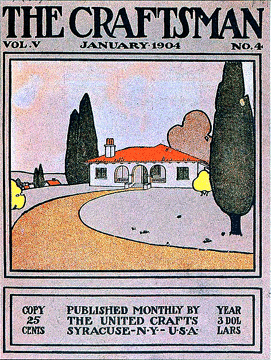 Gustav
Stickley was one of the most important figures in the Arts and Crafts
Movement in the United States. He was a furniture maker who became a
leader in the philosophy of the Arts and Crafts Movement as well as in
the production of objects suitable for use that followed its principles.
And although he wasn’t a craftsman himself, he successfully inspired
craftsmen to carry out his concepts. Gustav
Stickley was one of the most important figures in the Arts and Crafts
Movement in the United States. He was a furniture maker who became a
leader in the philosophy of the Arts and Crafts Movement as well as in
the production of objects suitable for use that followed its principles.
And although he wasn’t a craftsman himself, he successfully inspired
craftsmen to carry out his concepts.
Stickley founded a periodical, entitled The Craftsman, in 1901. It’s
main mission was to bring the philosophy of the English Arts & Crafts
movement to American readers. As it matured, the publication became the
leading voice of that movement in the United States.
A Promotional Tool
Stickley used his magazine,, which he edited and published during the 15
years he was active in the Arts and Crafts Movement, to promote his
products and his ideas. At its height, The Craftsman had 60,000
subscribers and featured articles and essays on Stickley's many
interests and concerns.
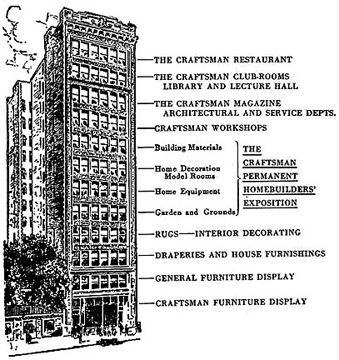 He
published the first issue of his magazine in October 1901 in Eastwood,
New.York, where he had located United Crafts, his furniture factory.
Later he moved The Craftsman to Syracuse and finally to his lavish
headquarters in the Craftsman Building in New York City. The premier
issue emphasized the work and ideas of William Morris through an article
entitled “William Morris, Some Thoughts Upon His Life.” He
published the first issue of his magazine in October 1901 in Eastwood,
New.York, where he had located United Crafts, his furniture factory.
Later he moved The Craftsman to Syracuse and finally to his lavish
headquarters in the Craftsman Building in New York City. The premier
issue emphasized the work and ideas of William Morris through an article
entitled “William Morris, Some Thoughts Upon His Life.”
Irene Sargent, professor of art history at the University of Syracuse,
served as Stickley's principal editor. She wrote many of the articles in
the magazine’s early years. A very persuasive person, Stickley was also
able to convince notables such as Louis Sullivan, Jacob Riis, Leopold
Stokowski, John Burroughs, and Jane Addams to contribute articles as
well. These covered a wide variety of subject matter, from architecture
to art and nature, as well as the concepts of social reform prevalent at
the time.
Though he was an idealist, Gustav Stickley needed to make a living. The
Craftsman offered him lots of advertising space for his growing
furniture business. Thirteen pictures of furniture made by Stickley's
company, United Crafts, included a round table, an armchair, and a
settle, followed an article entitled “An Argument for Simplicity in
Household Furnishings” in the first issue. The Craftsman also showed
readers how to use the furniture in its many illustrations of room
settings. Over the years, Stickley added metalwork, lighting fixtures,
textiles and other items to his product line, and also to The Craftsman.
The Craftsman Ideal
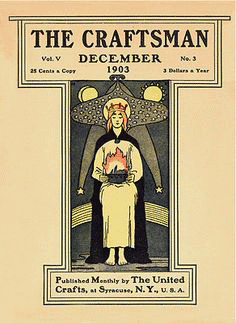 He
often commented on the Craftsman ideal. Stickley believed an ideal kind
of life encompassed beauty, economy, reason, comfort, and progress. It
didn’t satisfy him to merely achieve this ideal in furniture. He felt
strongly that consumers must also have the right kind of houses in which
to place the furniture, so he began designing Craftsman houses. Working
with architect Harvey Ellis, he designed house plans for the magazine
that later appeared in two books: Craftsman Homes, appearing in 1909 and
More Craftsman Homes, in 1912. These books not only illustrated the
homes' exteriors and interiors, but showed a floor plan as well. He
often commented on the Craftsman ideal. Stickley believed an ideal kind
of life encompassed beauty, economy, reason, comfort, and progress. It
didn’t satisfy him to merely achieve this ideal in furniture. He felt
strongly that consumers must also have the right kind of houses in which
to place the furniture, so he began designing Craftsman houses. Working
with architect Harvey Ellis, he designed house plans for the magazine
that later appeared in two books: Craftsman Homes, appearing in 1909 and
More Craftsman Homes, in 1912. These books not only illustrated the
homes' exteriors and interiors, but showed a floor plan as well.
Stickley no sooner began designing Craftsman houses than he realized
that people wanted Craftsman fabrics and accessories of all kinds. In
other words, he believed in the concept of total interior design.
While early issues had somewhat smaller covers, ones beginning in 1913
had larger ones measuring 8 by 11 inches. Stickley printed all of them
on brown or tan stock and usually featured a wood block decoration in
two or more colors, initialed by the artist. Each issue consisted of
100-140 white and glossy pages, and later ones had as many as 175 pages.
Between the Covers
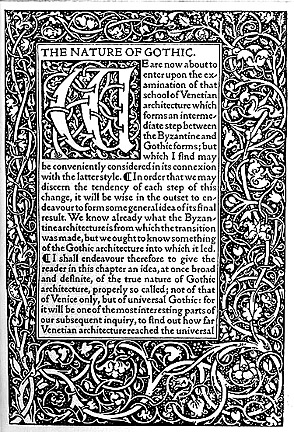 Plans
for Craftsman houses, some small and simple, others more elaborate,
attributed to Stickley as the architect, although he had no
architectural training. People built many of these houses using
Stickley’s plans. The Craftsman also featured short fiction and poetry,
as well as the work of famous photographers. Plans
for Craftsman houses, some small and simple, others more elaborate,
attributed to Stickley as the architect, although he had no
architectural training. People built many of these houses using
Stickley’s plans. The Craftsman also featured short fiction and poetry,
as well as the work of famous photographers.
Besides articles about Stickley’s products, The Craftsman often included
ones about other makers of Arts and Crafts objects. For example, a 1903
article, “An Art Industry of the Bayous: The Pottery of Newcomb College”
by Irene Sargent, documents the early history of Newcomb pottery.
Photographs of the pottery school and examples of early high glaze
pieces accompanied it. There were also essays devoted to philosophical,
political and social commentary, usually promoting the simple life
The magazine also offered all kinds of practical and how-to advice, from
gardening to leather tooling to embroidery to purchasing household
appliances.
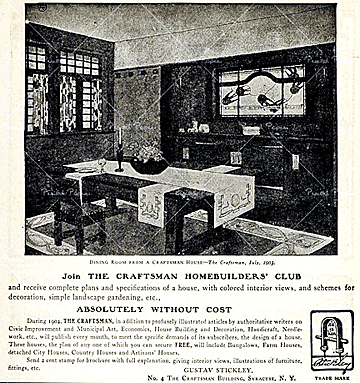 t
also included advertisements by manufacturers whose products are now
greatly valued by collectors, for example, Rookwood pottery, Heisey
glassware, Handel lamps, and Homer Laughlin china. t
also included advertisements by manufacturers whose products are now
greatly valued by collectors, for example, Rookwood pottery, Heisey
glassware, Handel lamps, and Homer Laughlin china.
Unfortunately, Stickley overextended himself and in 1915 had to file for
bankruptcy. The Craftsman magazine never hinted at these financial
problems right through its final issue in December 1916. The Craftsman
then merged with another magazine, Art World . His last editor, Mary
Fanton Roberts, joined with others to found a new magazine, The
Touchstone. Stickley had no further associations with either
publication. But The Craftsman was the first periodical to emphasize the
importance of harmony in a home’s interior, harmony which was to be
created through attention paid to walls, floors, windows, textiles,
small objects and furniture.
Copies of The Craftsman are highly collectible. Prices range from $20 to
$70 for individual issues, depending on the content and condition. For
example, the April 1908 issue recently sold on eBay for $35 with content
including an article by Ida Tarbell and From the Craftsman Workshops
“Some Camp Furniture and Fireplace Fittings that Can Be Made at Home.”
It had a badly damaged cover. A copy from September 1909, in very good
condition, with an article on California landscapes, sold for $61.99.
Collectors can also purchase bound volumes, each containing six issues
of the magazine, for $75 to $150.
<
Back
to More Antique Spotlights
Next Article > |
